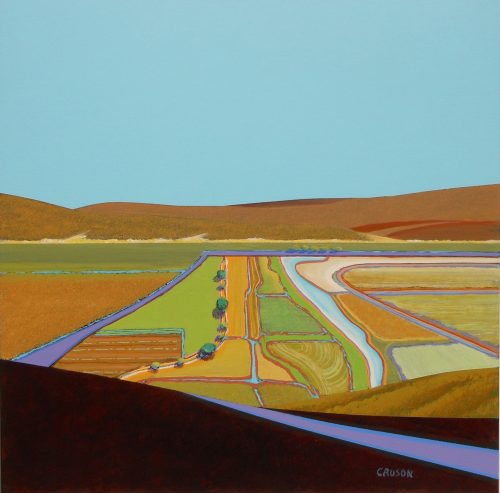
Eugene artists Jon Jay Cruson and Satoko Motouji both paint landscapes, but with strikingly different results. Cruson’s acrylic paintings are crisp exercises in design with an emphasis on shape and color. Motouji’s sumi ink landscapes lean into the fluidity of her medium. Their work in White Lotus Gallery’s exhibit In Good Company: Works by Regional Artists will be up until Aug. 15 and available for viewing by appointment.
This year Cruson has had one art show canceled and one postponed. The latter was to take place at White Lotus this spring and has been rescheduled for winter, though he acknowledges no one knows for sure what the winter will bring.
“Does knowing you won’t have a face-to-face exhibit change the way you feel about making art?” I ask him.
“Artists are no different than anyone else,” Cruson says, adding that they respond in various ways. He knows artists — good artists, he clarifies — who need the lure of an exhibit as motivation to make art. He happens not to be one of them. He has been making a living as a full-time artist since 1970, he explains, and has worked through the ups and downs. “And when I have a sale, some of that is set aside for down times.”
Cruson has a routine. After he returns from his winter vacation in Mexico, he travels to eastern Oregon, eastern Washington and northern California to “just look and think.” He spends time making the sketches that will inform his studio work and determining what his focus will be.
This year he’s had to shift gears, as his travels have been restricted. The preamble to his studio paintings has been cut from five-day stints to day trips. Rather than getting a new hit on his direction or focus, as he is accustomed to, he has continued working along the same lines as before.
But Cruson recognizes he’s lucky, having been able to save for a down time, and he’s also good at budgeting. Unlike him, some artists are taking more of a hit in terms of canceled shows. Cancellations can have a psychological impact, and museum closures have also hurt artists, he says.
The Portland Art Museum (PAM) has its Rental Sales Gallery that rents artworks out for limited amounts of time, and then if people want to keep a work they can buy it. Cruson has lent his work to the gallery at PAM and previously to the rental sales gallery at the Seattle Art Museum. The PAM gallery is still doing business online, but since the museum is closed the operation is only open by appointment.
Lots of artists rely on those rental commissions and sales, Cruson says. According to PAM’s Rental Sales Gallery’s website, “There are at least 600 pieces of art in the gallery at any one time.”
Motouji acknowledges her luck too. Retired from her job teaching art at Lane Community College, she is concerned for young people starting out in their careers. Making art for her is not tied to survival, though she does think about survival and has since before the pandemic.
Last year at a residency with the Ucross Foundation in Wyoming she created a series titled “Rift,” whose paintings are intended to picture the environment as cracked. One painting from this series will be exhibited at Karin Clarke Gallery’s Eugene Biennial, which is to open Aug. 5.
When the shut-in hit in March, Motouji says she felt “frozen.” She had to adjust to the new way of doing things, such as shopping in the morning during senior hour to keep from potentially contracting COVID-19.
“It was surreal,” she says.
In April she began painting en plein air. Like Cruson, she considers working directly from nature part of her artistic process, even though her finished studio pieces are interpretations, often more abstract than her outdoor work.
In May she made a series of “quarantine paintings,” which she shared on Facebook. In June she worked on a large calligraphy piece for her teacher — she has been studying calligraphy for more than a decade — and in June she gardened. Gardening is reassuring, she says. It reaffirms to her “how important nature is.”
She describes “touching the Earth” as soul saving.
How has the pandemic affected her work?
It has enforced themes already present in her art — sustainability, change and uncertainty. Looking at her paintings at White Lotus, you can see she doesn’t try to completely control how the ink flows.
“Everything is uncertainty,” she says.
In Good Company: Works by Regional Artists runs at White Lotus Gallery, 767 Willamette Street, through Aug. 15 and is open by appointment only; email Lin@wlotus.com to arrange a viewing.